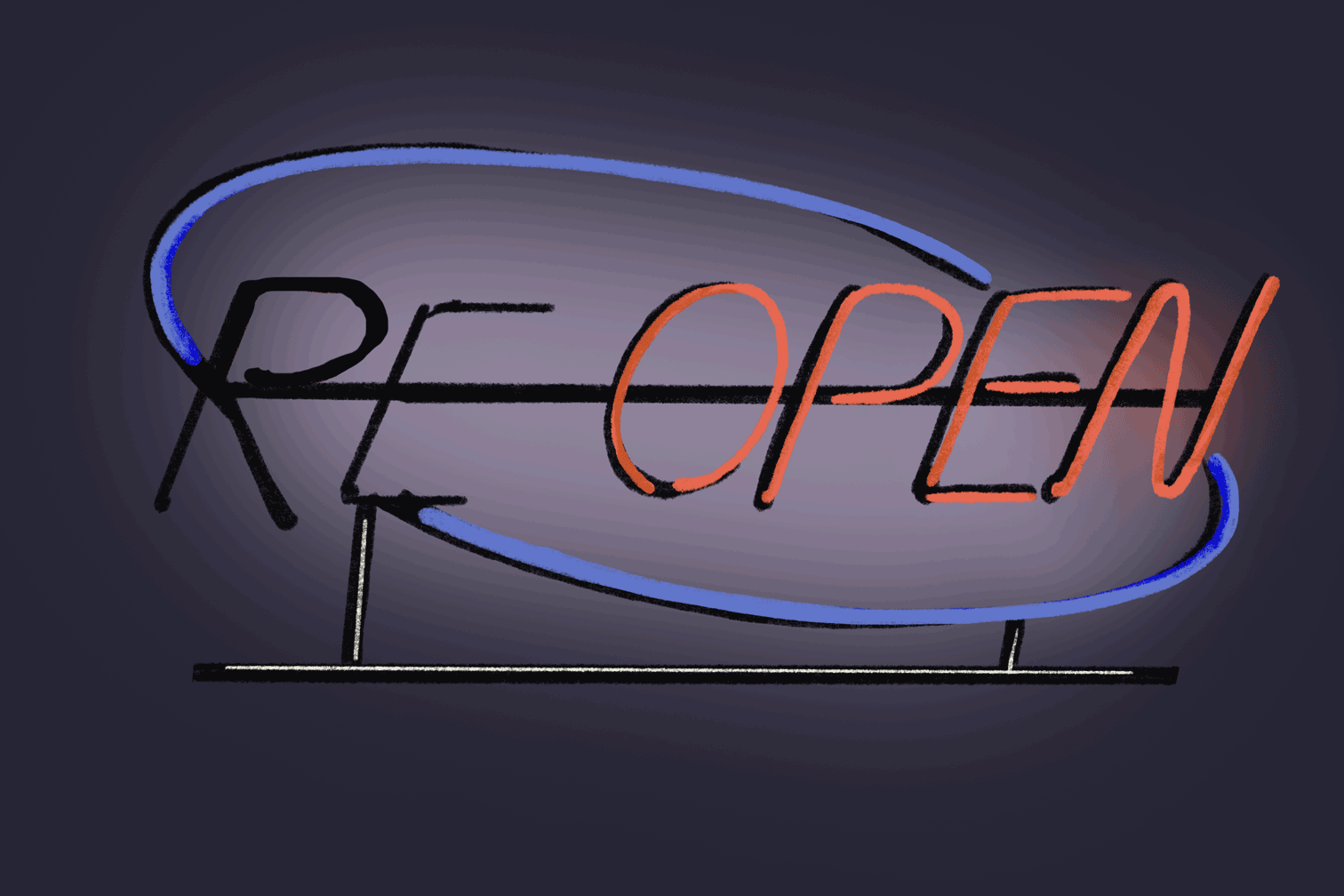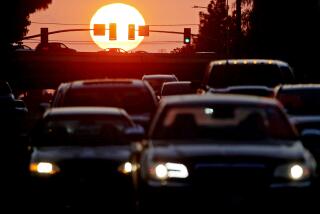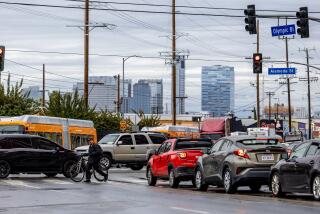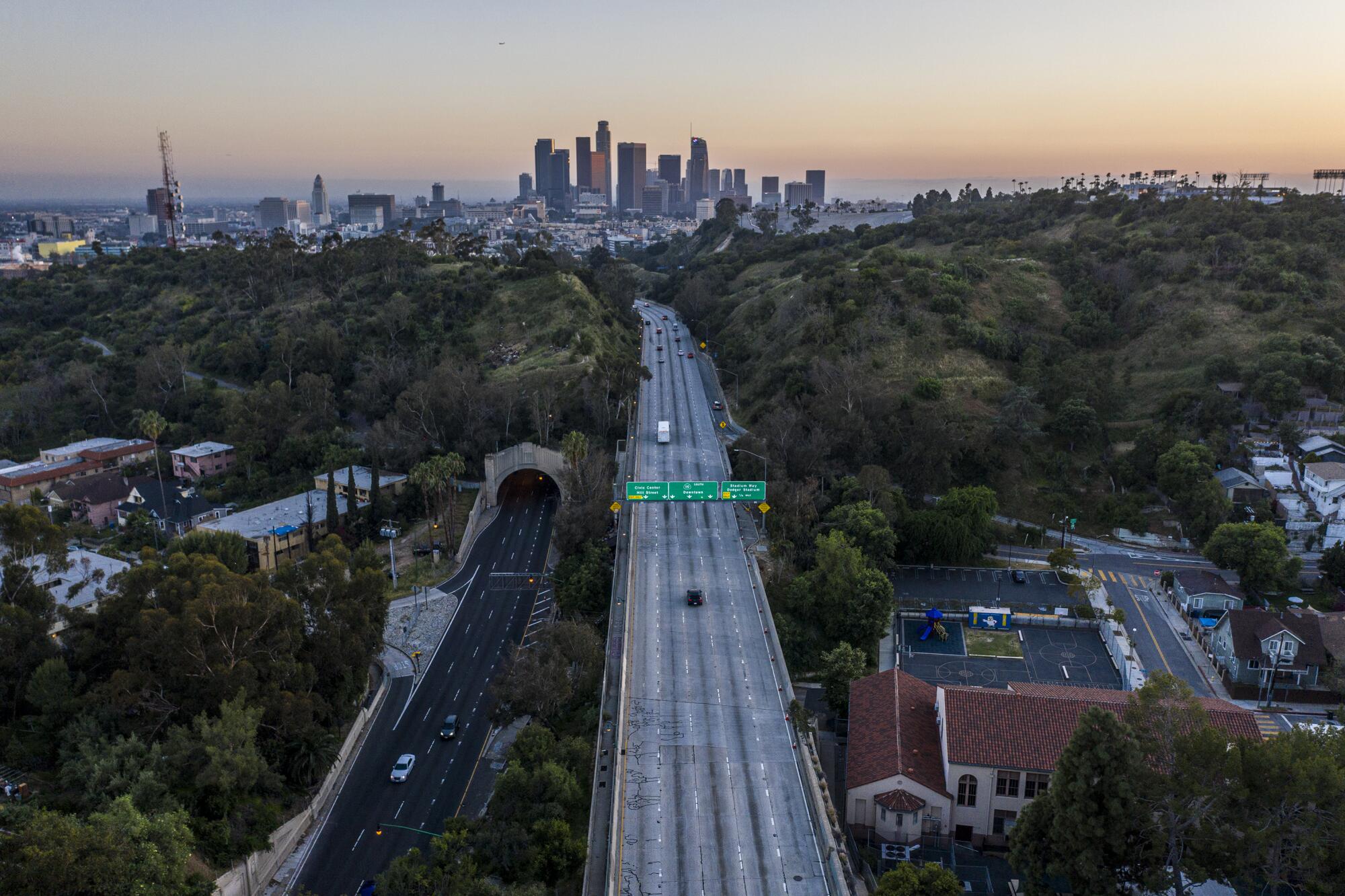
- Share via
As Los Angeles reopens after enduring more than a year of COVID-19 restrictions, those seemingly unbelievable ribbons of green on your phone’s freeway traffic app are rapidly returning to red.
Traffic and transit patterns were altered by the pandemic, and both transportation officials and drivers are anxiously waiting to see whether they offer clues to the future of commuting or simply represent temporary changes in L.A.’s inevitable slog toward gridlock.
Though congestion is rapidly approaching pre-pandemic levels, traffic flows have changed, according to data reviewed by The Times.
The findings are fairly consistent among L.A.’s major arteries. The afternoon commute has bounced back faster than the morning trek, which remains a bit more free-flowing in many areas.
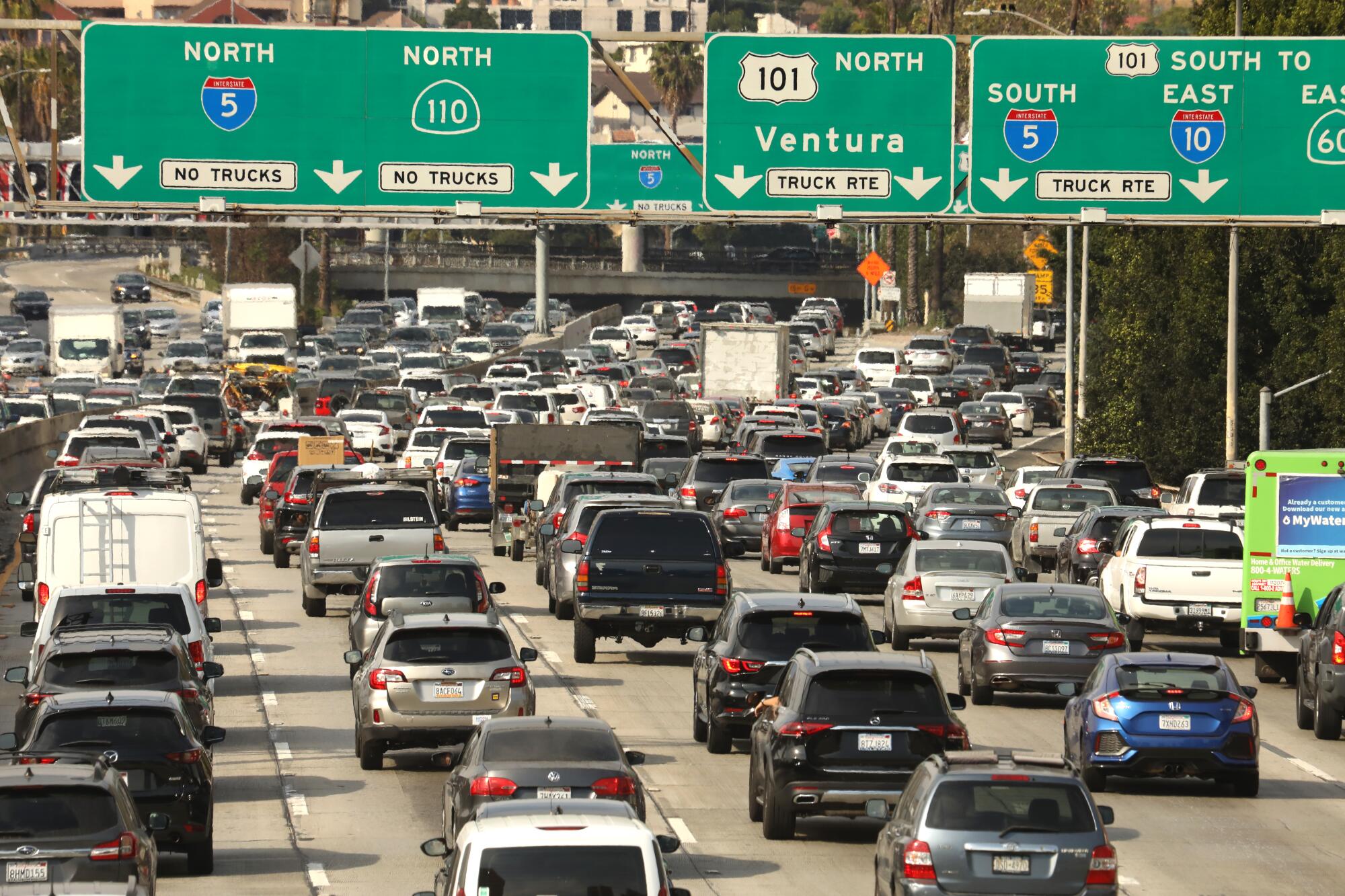
Both morning and evening rush hours are shorter than they used to be, with the latter jams clearing out by 7 p.m. instead of 8 or later.
“Traffic is almost as bad as it was pre-COVID, but how it looks throughout the day has shifted,” said Bob Pishue, a transportation analyst at the traffic data company Inrix, which tracked freeway flows for The Times.
The next few months will be crucial in determining whether the changes brought by the pandemic will alter what for more than a century has been one of the most bemoaned aspects of L.A. life.
One factor will be how flexible companies will be in requiring employees to return to the office. Some firms have talked about allowing employees to telecommute several days a week, which could ease the traffic burden in job centers. And at least 70% of U.S. workers say they would prefer to switch to a hybrid work-from-home schedule or stay remote full time, a recent survey by the Society for Human Resource Management found.
Another question is how many riders will return to buses, trains and subways. Mass transit took a big hit during the pandemic, but ridership is beginning to creep up again. Time will tell whether those numbers return to pre-2020 levels and how many people who abandoned mass transit will opt for cars instead.
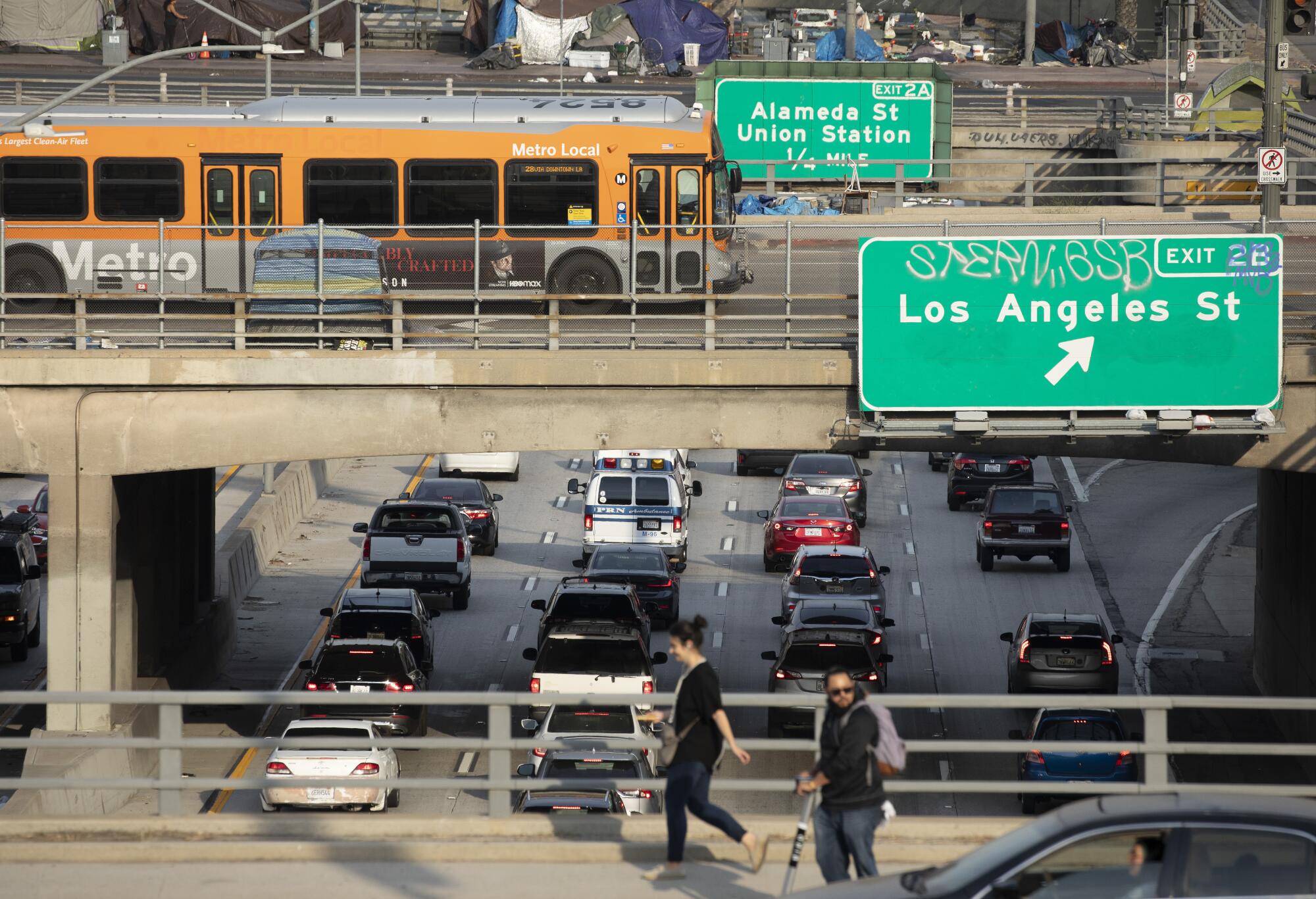
Perhaps the most predictable part of the traffic equation will come in September, when schools fully reopen for the first time in more than a year. The return of classes always worsens traffic, and 2021 will be no exception.
Few now believe the wildest predictions of 2020 will come to pass: that the coronavirus would disrupt L.A.’s notorious traffic once and for all. But changes in behavior and economics — including work, school and leisure travel — could determine the new normal.
When people refer to “traffic,” they are typically talking about two variables, said Brian Taylor, director of the Institute of Transportation Studies at UCLA. One is vehicle travel — meaning how much people drive — and the other is traffic congestion, which is what causes delays.
Currently, vehicle travel is increasing in part because more businesses and activities are opening up, prompting people to drive more often and farther from home.
But congestion is “spatially and temporally” structured, Taylor said, meaning that it occurs when many travelers are going to the same destination at the same time. As people return to normal patterns, traffic congestion will return.
“The question will be, as we recover from the pandemic, if people resort back to structuring their life activities in time and space,” Taylor said. “If we go back to pre-pandemic living and working patterns, driving and traffic levels are likely to be similar to before.”
With offices in California and elsewhere reopening, workers who’ve been doing their jobs remotely once again need to commute — or figure out how to avoid it for good.
Many people lost their jobs amid COVID-19 shutdowns, and more than half of the nation’s workforce began working from home, according to Gallup polls — transforming formerly bustling hubs into seeming ghost towns.
But in downtown Los Angeles, those empty streets are again full.
At a shoe store on South Broadway last week, about 30 people waited in line for a new Jordan sneaker while cars snaked down the block, honking in frustration. Kids sped down sidewalks on Lime and Bird scooters, and hundreds of people lined up for food at Grand Central Market.
“Traffic is definitely back,” said Aaron Cohen, 28, a courthouse worker having lunch outside the market.
The drive from his Fairfax home to downtown took 10 minutes last summer, Cohen said. Now, it takes about 25.
An Inrix analysis of four major L.A. corridors — the 405, 110, 5 and 10 freeways — found that travel speeds are rebounding to 2019 numbers.
On the northbound 5 in June 2020, for example, a driver could travel at an average of 61 mph at 10 a.m., compared with 43 mph at the same time in 2019. Today, those speeds are again around 40 mph.
The findings are a stark change from the earliest days of the state’s lockdown, when so few cars were on the road that L.A.’s notorious smog dissipated into some of the cleanest air quality in decades and people stopped to ogle at the eerie sight of empty freeways.
“Since March, I think people have been starting to notice that travel is starting to look like it did pre-COVID, and even more so as the weeks go on,” Pishue said. “It’s slow and gradual, but of course, [it happens] as things come back online.”
Inrix data primarily indicate pre-COVID congestion levels at the end of the day, Pishue said, when people are probably making a combination of business and personal trips.
Subscribers get early access to this story
We’re offering L.A. Times subscribers first access to our best journalism. Thank you for your support.
However, the congestion period is a little shorter now: It’s starting at 5 p.m. and easing after about two hours.
Mornings are also not quite as bad.
For example, at 8 a.m. this month, average speeds on the southbound 405 were 67 mph, compared with about 49 mph in June 2019. On the 10 Freeway heading west at 8 a.m., speeds have averaged 28 mph this month, compared with 22 mph in June 2019.
Pishue and other transit experts said it is difficult to forecast precisely what the coming months will hold because the pandemic has been such a unique experience.
“The morning commute is kind of like the last holdout,” Pishue said. “It’s kind of the last vestige of COVID, at least in the transportation network.”
But that could change.
The pandemic decimated ridership on the city’s buses and trains, with numbers dropping 70%, but officials are hoping a bigger network of bus and rail lines will make ditching a car more viable.
The Los Angeles County Metropolitan Transportation Authority used the quiet streets of the pandemic to advance and complete $2 billion worth of capital infrastructure projects, spokesman Brian Haas said, including breaking ground on the Purple Line extension.
Though rail ridership is creeping back up, it is increasing slowly “due to it being a major mobility option for commuters with office jobs, many of whom continue to telecommute and work from home,” Haas said.
“We expect to see more and more blended commutes, where people work from home only some days of the week,” he said.
The final leg of the Metro subway that eventually will take riders from downtown L.A. into the Westside broke ground on Monday.
The agency also took advantage of lower traffic volumes during the pandemic to install bus lanes and launch its NextGen Bus Plan for more frequent service on more corridors.
Bus riders have been returning, but they’re similarly not back in full force.
For the last four weeks, Metro has seen more than 500,000 average weekday bus system boardings, Haas said, up from 270,000 at the low point in April 2020. It’s still a long way from the almost 900,000 average weekday boardings before the pandemic.
At a bus stop on Fairfax Avenue and Santa Monica Boulevard in West Hollywood, Crystal Asencios, 18, of Compton said the buses were “pretty empty” last year but started noticeably filling up around February.
Waiting with her, Katherine Keuhne, 18, of West Hollywood said the typically busy streets of her neighborhood were “dead silent” during the pandemic.
“They were empty for the first time since my birth,” she said as she boarded a westbound bus. “But it’s coming back.”
In April 2020, the Los Angeles Department of Transportation recorded an “unprecedented decline in the number of cars on the road,” the agency said. In response, it shifted all traffic signal patterns to “night mode,” which interrupts successive green lights along major corridors to reduce speeding.
That changed Tuesday, when the department announced that traffic volumes have rebounded as much as 95% and that it would revert all traffic signals in the city to pre-pandemic timing patterns. Night mode will now begin at 7 p.m. and last until 6 a.m.
And although multiple experts said soaring gas costs can affect some people’s decision to drive, many Angelenos do not appear deterred by current prices, which are hovering around $4.25 a gallon.
“Leisure travel was looking good at the start of the year, but by the end of spring, it was looking very good,” said Doug Shupe, spokesman for the Automobile Club of Southern California.
The agency estimated that 53% more Californians traveled by car for Memorial Day 2021 than last year, and said even more are ready to hit the road in the months to come. Of Americans traveling this summer, nearly half will stay in their state.
“The reason why we’re seeing so much rebound in leisure travel all has to do with the increased vaccinations among the population, the decrease in COVID-19 cases across the country and just the pent-up demand,” Shupe said. “We believe that this summer is going to be huge for road trips.”
Some pandemic-wrought changes to the business world seem lasting. (Work from home? Yes, thank you.) Others not so much. Here’s our guide to the new normal.
While the relationship between Angelenos and their cars is a well-established trope, it remains to be seen whether the pandemic will fundamentally alter that connection.
Shutdowns and closures pushed people to rethink when and how they move around, with many sticking closer to home and limiting their outings.
In many neighborhoods, once-coveted parking spaces were transformed into accommodations for outdoor dining, with some pushing to make the change permanent.
But at one Hollywood carwash last week, all seven stalls were filled with people cleaning their vehicles, and several more were waiting in line.
Dren Cisneros, 23, was polishing the hubcaps on his gray 1991 Mercedes-Benz E-class and said driving through the streets during the pandemic “felt like a video game” where he could “drive as fast as I want.”
Cisneros first noticed traffic piling back up after the county allowed outdoor dining to resume in January, he said, and it’s only gotten worse.
As he spoke, a steady stream of cars rolled down the boulevard behind him. One driver honked, and another yelled an obscenity out the window.
“Now,” he said, “it’s almost like it was before.”
More to Read
Sign up for Essential California
The most important California stories and recommendations in your inbox every morning.
You may occasionally receive promotional content from the Los Angeles Times.


